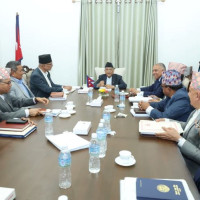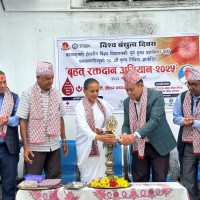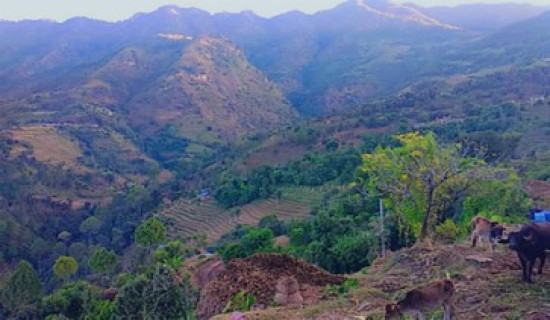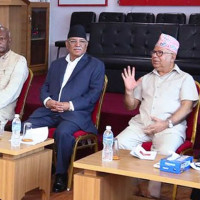- Saturday, 23 August 2025
Rain brings joy to drought-hit Madhes farmers
By Our Correspondents,Sarlahi/Mahottari, July 29: After weeks of parching drought, the skies over Madhes Province finally opened up, bringing much-needed rainfall to drought-stricken regions including Sarlahi and Mahottari, sparking hope and relief among anxious farmers.
In Sarlahi, intermittent weather changes over the past two days culminated in a brief but intense downpour on Monday afternoon, accompanied by thunderclaps. The rainfall brought significant relief, especially to farmers in the eastern plains and Chure belt who heavily depend on rainfall for irrigation.
Bilas Raya, a farmer from Haripurwa Municipality-2, shared that the rain arrived just in time to save his paddy seedlings, which were beginning to wilt after being transplanted using electric pumps amid water scarcity, according to our district correspondent Janarjan Khatri from Lalbandi, Sarlahi.
The rainfall extended across multiple areas in Sarlahi, including Haripurwa, Ishwarpur, Chandranagar, Lalbandi, Harion, Bagmati, Haripur, and Kabilasi. These regions, where rain-fed agriculture is the norm due to limited irrigation facilities, saw a rare, welcome shower.
According to Kamaldev Prasad Kushwaha, Chief of the Agriculture Knowledge Centre in Sarlahi, Monday's rainfall will greatly assist in completing paddy transplantation and improving the condition of already-planted crops. He said that areas receiving water from the Bagmati Irrigation Project’s canal system and regions equipped with motor pumps had continued planting despite the drought.
With the Chure region finally receiving rain, water levels have risen in streams like Banke, Phuljor, Kalinjor, and Lakhandehi, providing further irrigation relief through traditional canal systems.
In Lalbandi Municipality-16, local farmer Dil Bahadur Thapa shared that streams, which were nearly dry just days ago, have now been replenished thanks to the downpour. The rainfall has also brought a drop in temperatures across Madhes, providing additional comfort amid a relentless heat-wave.
Widespread showers rekindle hope in Bardibas region Meanwhile, our Mohattari District Correspondent Rabindra Upreti, reported that following an extended dry spell, northern Mahottari, including Bardibas, was drenched by steady rainfall on Monday afternoon, bringing new hope to the region’s farming communities.
The rain, which began around 3:30 pm after a day of sweltering heat and intermittent cloud cover, spread across Gauchaur, Aurahi, Bharatpur, and Khairmara, reaching as far as the border areas of Samsi.
Farmers, who had been anxiously awaiting rainfall, now feel hopeful about salvaging this season's harvest. Arjun Basnet from Khairmara, Bardibas-11, described the rainfall as ‘nectar from the sky,’ noting how water overflowed on roads as the rain continued.
However, despite dark clouds in southern areas like the district headquarters Jaleshwar, rainfall has yet to materialise in many parts.
Bipin Yadav, Ward Chairperson of Samsi Rural Municipality-1, said that with sufficient rainfall, there remains a chance to plant late-season rice (Mangsire paddy), which could bear the drought’s impact. Traditionally, local varieties such as Basmati, Kamod, and Harinkhej are planted in southern Madhes during late July to early August.
Devanand Raya, Chief of the Agricultural Knowledge Centre in Mahottari, stated that only 35 per cent of paddy transplantation has been completed in Mahottari, currently the lowest in Madhes Province. Although Monday’s rain in the northern belt has inspired cautious optimism, he warned that paddy nurseries have already withered or grown too mature, potentially causing seedling shortages even if more rain falls.
According to the Madhes Province Agriculture Directorate, by the end of July 25, only 51 per cent of the total 372,645 hectares designated for paddy cultivation has been planted, far behind last year’s 91.27 per cent during the same period.
Sudip Chaudhary, Plant Protection Officer at the Directorate, said that only 35 per cent of transplantation has been completed in both Mahottari and Dhanusha, compared to 85 per cent last year. In contrast, Parsa leads the region with 81 per cent completion, followed by Bara (80%), Rautahat (68%), Sarlahi (56%), Siraha (38%), and Saptari (37%).
Chaudhary added that the latest weather changes suggest more rain may be on the way. “If the rain continues steadily, it could mark the end of the drought and bring significant relief to Madhes’s rice cultivation,” he said.
According to senior meteorologist and spokesperson for the Meteorological Forecasting Division, Bibhuti Pokhrel, as shown by the Gaur station (0922) in Rautahat, it has recorded 23.2 mm rainfall since 4:00 pm as of 6:00 pm on Monday.
Likewise, Parwanipur, Sarlahi-based station (110901) registered 23.8 mm rainfall from 3:00 pm to 6:00 pm on Monday. Similarly, Parsa district recorded 26.4 mm rainfall in the last two hours from 4:00 pm. Although all the regions (eight districts of Madhes) fail to receive equal rain, there is more chance of heavy rainfall in the coming days, she said.















